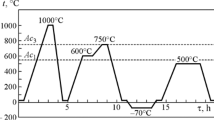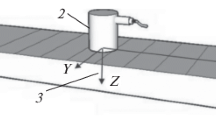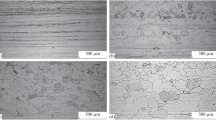Conclusions
-
1.
The mechanical properties of the investigated steels at normal and cryogenic temperatures improve when their aluminum content increases to 10%. Further alloying with aluminum causes some impairement of the plastic and ductile properties; this is connected with the formation of α-phase in the structure of the steels.
-
2.
Magnetic permeability is practically independent of the temperature in the range 293–4°K because of the complex magnetic transformations occurring during the freezing of steels.
-
3.
When steels are deformed with ε=40%, their texture is transformed, and this is accompanied by the displacement of the principal orientation of the texture from {110}<001> to {110}<112>. Such transformation leads to an anomalous decrease of magnetic permeability and electric resistivity of steels.
Similar content being viewed by others
Additional information
Leningrad Polytechnic Institute. Translated from Metallovedenie i Termicheskaya Obrabotka Metallov, No. 4, pp. 29–31, April, 1986.
Rights and permissions
About this article
Cite this article
Ermakov, B.S., Nikolaich, A.Y. & Oparin, V.A. Steels for cryogenic power engineering. Met Sci Heat Treat 28, 265–267 (1986). https://doi.org/10.1007/BF00707653
Issue Date:
DOI: https://doi.org/10.1007/BF00707653




